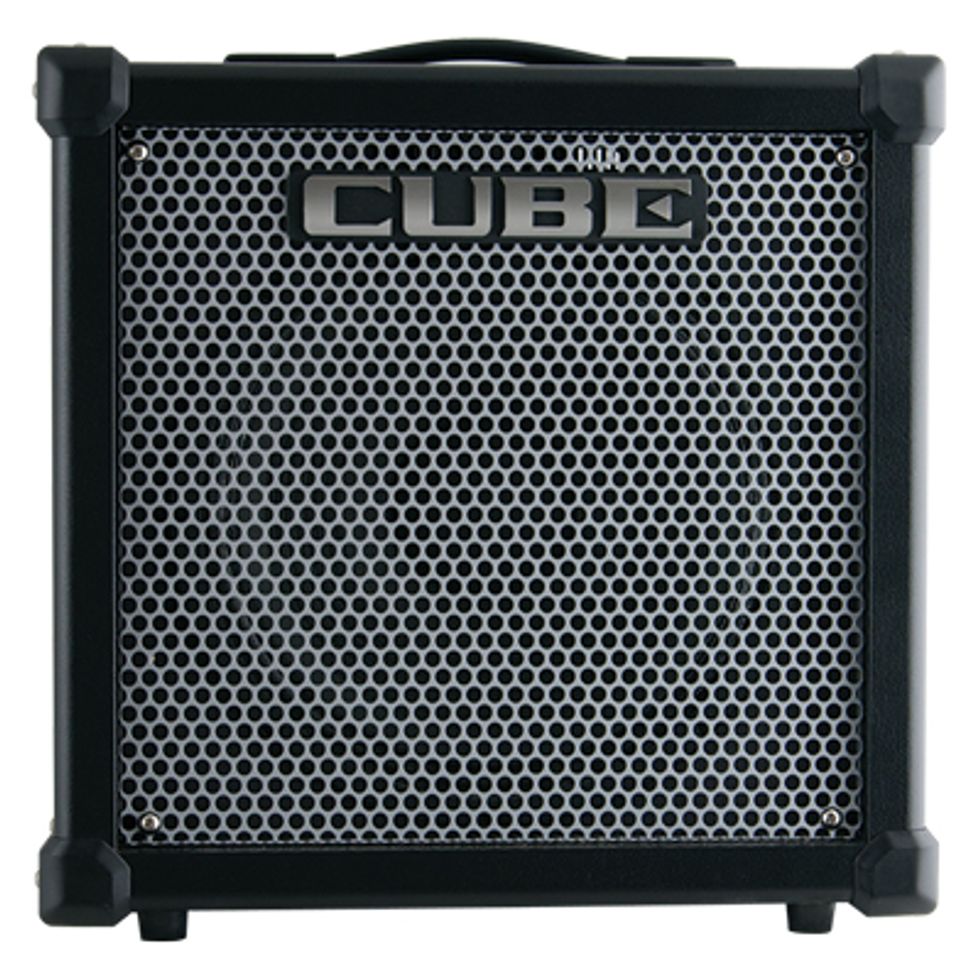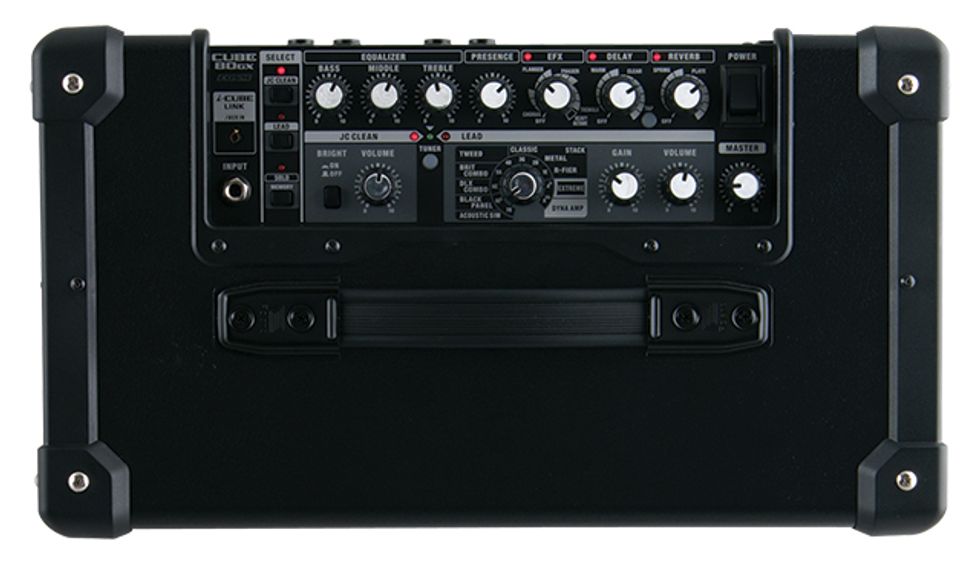Roland introduced the Micro Cube in 2005 to the delight of street buskers the world over. The compact, battery-powered amp quickly became the benchmark in portability and a fixture for anyone engaging in small-scale, spur-of-the-moment gigging in unlikely locales. Over the years, Roland has expanded the Cube family considerably in both wattage and size. This summer marks the release of the Cube GX series, which comes in 20-, 40-, and 80-watt models and builds on with the company’s COSM (composite object sound modeling) audio software to hone a formula that’s always delivered a lot of bang for the buck to players who need to cover a lot of musical ground on a budget. Here, we’ll take a look at the 80-watt Cube 80GX.
Cube Control
Anyone who has spent time with previous Cube versions, especially the more recent 80XL, will be perfectly at home with the GX. And the differences in the control layout and expanded sonic possibilities are welcome developments. Like the 80XL, the 80GX has three channels—JC Clean, Lead, and Solo. JC Clean aims to capture the sound of the renowned Jazz Chorus-120, and engaging the bright switch boosts the mid and treble presence for a more cutting and crisp tone—which, when we’re talking about a JC-120, is pretty crisp. The Lead channel has a 10-position rotary switch for selecting amp type—from acoustic sounds to tweed and heavily distorted settings. The third channel is called Solo, but it’s essentially any preset you dial up and save by holding down its button.
Bass, middle, and treble knobs govern all three channels, and the presence knob works a lot like the bright switch on the JC Clean channel, though it has much greater range. The EFX control lets you choose from five effects—chorus, flanger, phaser, tremolo, and heavy octave. Having all the effects on a single knob saves space but sacrifices versatility and control. And you have to move through the whole rate spectrum of a given effect before you click over to the next, which then engages at the lowest rate. Intensity and mix are set at fixed points, and the delay works in a similar fashion—repeats are fixed at around five, and turning the control clockwise increases the ratio of delay to dry signal. The “warm” delay has a more analog feel, while “clear” has a more digital-like repeat. A tap button, meanwhile, enables you to set the repeat rate. Reverb also comes in two flavors, spring and plate, but feedback is fixed, and turning the knob clockwise increases intensity.
Roland’s newest feature is the i-Cube link, located above the input jack. Connecting the provided 1/4" (4-pole) mini cable to the headphone jack in your computer, iPhone, iPad, or other digital device allows you to jam along with audio files. Further, the Cube Jam app for iOS devices enables basic recording over tracks from your playlist. You can even tweak recording and master levels, as well as the speed and pitch of playback.
Stacking Effects and Tweaking Tones
The 80GX’s JC Clean channel is a fine approximation of the powerhouse amp whose super-clean, high-headroom tones have appeared on everything from new age to shoegaze albums. That said, an authentic JC-120, with its dual speakers and large, open-back cabinet, will certainly sound airier than the 80GX. With a single 12" speaker and a closed back, the overall output of the 80GX—regardless of channel—is stouter than what you’d hear from an open cab.
I routed a handful of pedals through the JC Clean channel, and they all rang with precision and clarity. The bright switch was a little harsh for single-coils, though it gave humbuckers a welcome cutting edge. But while the 80GX was a great blank slate for my pedals, the onboard effects left me pretty impressed, too—and you can stack up to three of them. I preferred the spring reverb and its longer tail. It’s a bit brighter than most spring simulations, and you don’t get the magical clang of an actual spring, but it has nice body and breadth without dominating your sound. However, the limitations of the delay are a tad frustrating, because you can’t change the number of repeats. This means you can’t, say, get a true country- or rockabilly-style slapback, because you’d want up to three repeats instead of five. The warm delay, however, does have a very natural analog feel, though it’s a bit bright. Pairing it with a nice dose of spring ’verb and the Lead channel’s “black panel” tone is a nice, Fender-esque alternative to JC Clean.
The Lead channel’s “acoustic" sound bears little resemblance to an actual acoustic—upper frequencies are brassy and it mostly comes off as a rather thin-sounding electric guitar. Single-coils will get closer to an acoustic sound, especially when you use the neck pickup and roll back the guitar’s tone a touch. Here you can find stronger hints of hollowbody resonance, but while it’s a serviceable stand-in for an acoustic in a busy band mix, it’s not a viable replacement in a solo or small-combo situation.
Ratings
Pros: Sturdy, compact construction. Very versatile. i-Cube
offers fun, convenient practice tools.
Cons: Onboard effects have control limitations.
Tones:
Ease of Use:
Build/Design:
Value:
Street:
$419
rolandus.com
The Lead channel’s “classic stack” sound delivers enough bristling attack to make it a clear nod to Marshall plexi tone. Both humbuckers and single-coils worked well in with this gainer sound, as well as with the “metal stack” and “r-fier stack” sounds. The stack settings are far from flawless simulations, but they certainly capture the spirit of these expensive amps. These more aggressive combinations work especially well as Solo-channel presets, and they also match up well with the rhythm tones you’re likely to also create with the Lead channel. You can even use a footswitch to mimic a 2-channel Marshall or Mesa/Boogie head.
The Verdict
It’s difficult to deploy an army of onboard effects and amplifier voices in a single, affordable combo without making a few sacrifices. Vintage-tone sticklers who rely on the purity of a genuine blackface Fender or a Marshall plexi aren’t going to abandon the real thing for the Cube 80GX. But if you’re looking for a convenient, Swiss Army knife-type amp and can roll with the limitations inherent in this size and price bracket, the 80GX puts a wealth of tone at your fingertips. And those who need enough sounds to cover everything from Skynyrd to the Police with a super-portable rig they can use anywhere—from the farmers market to bars—will potentially find the Cube 80GX a godsend.









![Rig Rundown: Russian Circles’ Mike Sullivan [2025]](https://www.premierguitar.com/media-library/youtube.jpg?id=62303631&width=1245&height=700&quality=70&coordinates=0%2C0%2C0%2C0)

















